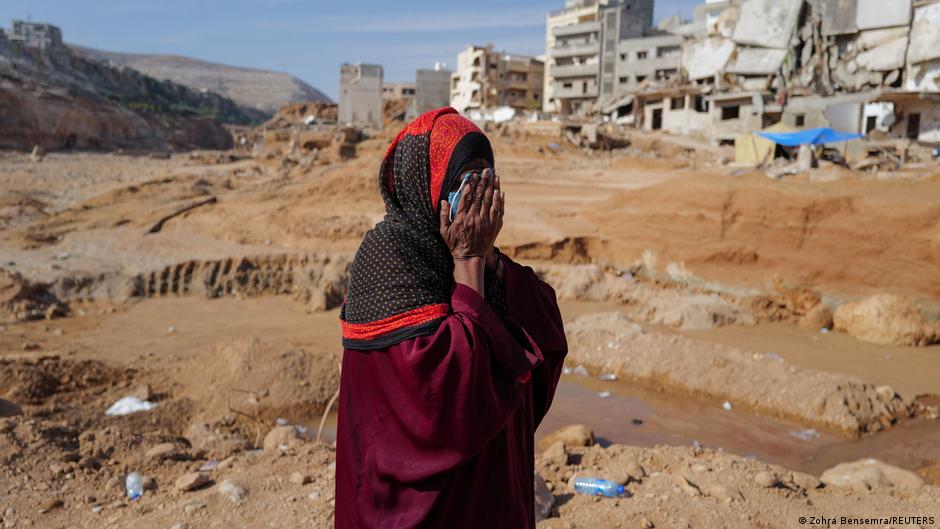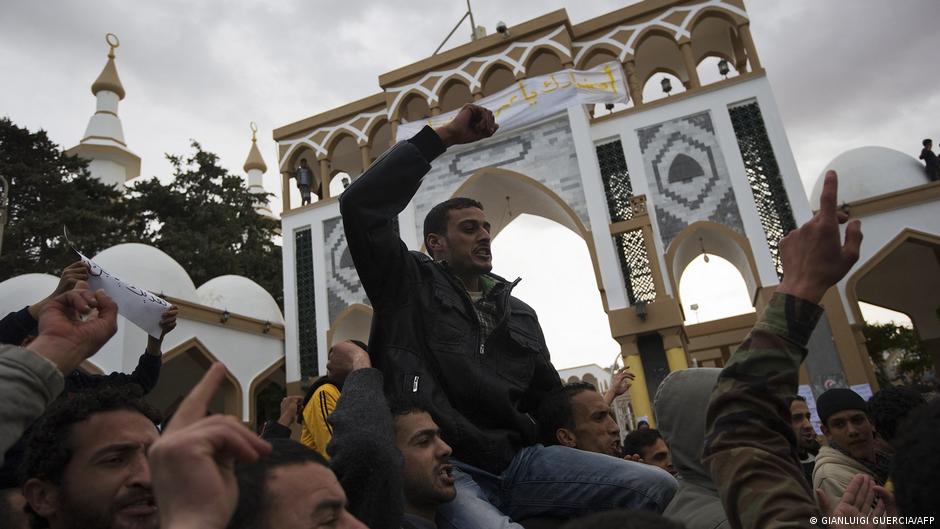A city known for rebellion – and neglect

Throughout its history, the coastal Libyan city of Derna has been both feared and revered. Founded in the late 15th century on the site of an ancient Greek colony, the eastern port city was well-known as a centre of intellectualism and independent thinking, cosmopolitanism, art and culture. Home to around 100,000 people, it was also renowned for its attractive location on the Mediterranean coast, flanked by some of arid Libya's only green forests.
After last week's catastrophic flooding, experts have said the city's historical reputation and its desirable coastal location were decisive factors contributing to the major devastation and high number of deaths – over 11,000 and still rising, with many more still missing – caused by Storm Daniel.
City of rebels
In 2011, during the so-called Arab Spring, Derna locals, along with people in the neighbouring coastal city of Benghazi, about 350 kilometres to the west, were some of the first to demonstrate against the country's 42-year dictatorship.

Over the decades, Libya's authoritarian ruler Muammar Gaddafi had built up a loyal power base in the west of the country, networked around the city of Tripoli. Gaddafi had not paid less attention to the east, and cities like Derna and Benghazi had long suffered from policies of economic exclusion.
This was also partially because the people of Derna had expressed opposition to Gaddafi's rule ever since the 1970s. The city's revolutionary reputation was also moulded by individuals who favoured more rigid forms of Islam who, united by their religious values, would eventually fight Gaddafi. In return, the dictator brutalised Derna and left its infrastructure to crumble.
In the 1990s, men from Derna joined the anti-Gaddafi Libyan Islamic Fighting Group, or LIFG. Gaddafi launched a brutal crackdown in Derna, sending people door-to-door to find LIFG members. The dictator also meted out blanket punishment by demolishing homes and cutting off water and power to the city. In 1996, many of the victims of an infamous jail massacre in Tripoli were from Derna.
"The city eroded progressively – no schools, and the hospitals were in very poor condition, neglected infrastructure," Hani Shennib, president of the National Council of U.S.-Libya Relations, told the BBC this week. A Guardian journalist visiting Derna in 2011 noted that "Derna's apartments and office blocks are shabby compared with elsewhere in the country, and sewage leaks on the main streets".
“In Derna, and indeed across Libya, everyone is sharing a poem called The Rain,” @patrickwintour reports.
A poet from Derna wrote it last week after attending a meeting on the sorry state of nearby dams.
His warnings went unheeded. He died in the floods.https://t.co/tqlexkx4SR pic.twitter.com/qwXHiEM6LZ— Monica Marks (@MonicaLMarks) September 15, 2023
This neglect has continued over the years, Hussein bin Dish, a city official from Derna, told journalists from the European Broadcasting Union: "Nothing is working here, no national authorities, nothing," he said angrily. "Have a look and do something about it! We are experiencing a great injustice."
A city of Islamist extremists?
During Libya's 2011 revolution, Gaddafi often repeated claims that protests in Derna were being incited by Islamist extremists and groups like al-Qaida. Experts have argued the city's oppositional attitude only partially stems from its being a centre for hard-line Islamist dissent. It also comes from Derna's long tradition of intellectualism and counterculture.
After the Gaddafi regime was ousted in 2011, Derna was – like the rest of Libya – at the mercy of various militias and fighting groups. One of Derna's most powerful groups was the Abu Salim Martyrs Brigade, founded by a former LIFG member.
In 2014, defectors from this powerful militia pledged allegiance to the extremist Islamic State group and took control of Derna. Their "rule was marked largely by beheadings and other forms of execution, or acts of public humiliation," Andrew McGregor, a Canadian expert on security issues in the Islamic world, wrote in a 2018 report for the Jamestown Foundation, a U.S. think tank.
Others in the city fought back, but it was not until 2016 that "Islamic State" was finally pushed out of the city altogether. Unfortunately for civilians in Derna that wasn't the end of the fighting.

Libya has been split into two since 2014, with opposing governments located in the east and west of the country, respectively. A United Nations-backed administration known as the Government of National Unity is based in Tripoli in the west, and its rival, known as the House of Representatives, is based in the east, in Tobruk.
Libyan warlord, Khalifa Haftar, whose Libyan National Army, or LNA, controlled much of the eastern half of the country, also wanted to take Derna. His forces besieged the city in 2015, even while the Islamist groups were still fighting inside it. It was not until 2018 that Haftar's forces managed to take control.
The fighting in Derna was brutal, but the international community averted its eyes from what was happening, McGregor noted, because it had "no particular objection to the elimination of this long-time Islamist hotbed". Even after the violence ended in 2018, Derna continued to be ignored and neglected by those in power in eastern Libya because it was still known as a rebellious city.
"Libyans are in shock and blame corrupt administrations who squabble over power instead of governing, as well as embezzling funds earmarked to rebuild Derna after the 2018 war [and] ignoring warnings over the dams," Tarek Megerisi, a senior policy fellow with the Middle East and North Africa program at the European Council on Foreign Relations, wrote this week.

Experts said Haftar still doesn't trust the people of Derna, fearing the seeds of another revolution may still lie dormant inside the city. In fact, earlier this month, Derna's municipal elections were cancelled, thus allowing the LNA to remain in power there, explained Anas El Gomati, director of the Libyan think tank Sadeq Institute.
"Local elections that should have taken place several weeks ago in Derna were cancelled in favour of the military [who will be] ruling for five more years," he explained. "But what have they done in the past five years, apart from plunder the economy, destroy the city and sell the scrap metal for a billion dollars?" he asked, referring to a 2019 report by the Global Initiative Against Transnational Organized Crime that looked at how the LNA was funded.
Scenic countryside contributed to flooding
Derna's vaunted scenic location was also a factor in the flooding that devastated the city this week. Dotted with ancient churches and mosques, famous for its agriculture and bordered by beaches, the city is built on what is known as an alluvial fan. This is where land is formed at the bottom of mountains by sediment that has been washed down rivers and streams toward the sea. The city is split in two by a river, or "wadi", that is dry most of the year.
This kind of geography is prone to flooding and Derna has experienced many over the years. In 1941, during World War II, a deluge swept away German tanks and soldiers stationed on the outskirts of Derna. There were also major floods in 1956, 1959, 1968 and 1986, with the overflows in 1959 having been the worst until now.
Regular flooding was why Derna's two dams, named Mansour and Derna, were built between 1973 and 1977 by Hidrotehnika-Hidroenergetika, a company from the former Yugoslavia. The dams were a form of flood control, as well as a way of managing soil erosion and irrigating surrounding farmlands, the company reported.
Mapping Libya’s catastrophic flood damage in Derna after Storm Daniel | Maps News | Al Jazeera https://t.co/utRDgiPxrc
— Oz Hassan - FHEA FRSA (@ozhassan) September 13, 2023
Derna's last flood occurred in 2011 after local authorities tried unsuccessfully to drain water from the dams. But even before that, it was clear to Derna locals that the dams had not been properly managed for years. It is unclear when the dams last underwent maintenance. It could have been in 2002, locals have told journalists, or as far back as 1983.
But, as one Derna man told the European Broadcasting Union, "We warned the authorities for weeks – no, years – that the dam had cracks in it and needed maintenance. We said it and nobody listened to us. Now the whole of Derna is flooded," he lamented.
Despite this, the dams also gave some Derna residents a false sense of security. The city grew in an unplanned, haphazard way, with buildings erected or extended into areas that had previously seen regular flooding.
Even so, when the harsh reality of last week's floods came, it was not simply a matter of poor maintenance. Hydrological experts have also pointed out that the dams were simply not built to deal with such heavy rainfall, having been constructed before the effects of climate change took hold.
Cathrin Schaer
© Deutsche Welle 2023